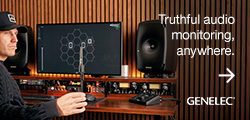Following Dolby’s discontinuatio of the DP570 Multichannel Audio Tool, dynamics specialist Jünger Audio has the only loudness processor capable of offering real-time metadata emulation as standard in the D*AP8 MAP Monitoring Audio Processor.
 Jünger Audio’s D*AP8 MAP Monitoring Audio Processor combines an audio monitor controller and a loudness measurement device in one unit, thus providing comprehensive quality control and loudness monitoring for anyone working in a production or broadcast environment.
Jünger Audio’s D*AP8 MAP Monitoring Audio Processor combines an audio monitor controller and a loudness measurement device in one unit, thus providing comprehensive quality control and loudness monitoring for anyone working in a production or broadcast environment.
Designed for quality checking surround (5.1) and/or stereo programmes, D*AP8 MAP features a built-in Dolby® Metadata generator and an optional Dolby decoder that allows users to decode Dolby-E, Dolby-D (AC-3) and Dolby Digital plus (E-AC-3). It can also be used for live monitoring and to ensure compliance with today’s standards and regulations (ITU 1770-3, ATSC A/85 or EBU R128).
The unit generates alarm signals to alert an operator when preset loudness thresholds are exceeded, and these signals can be delivered by simple GPOs and/or SNMP traps, which carry actual loudness values. Loudness measurements can be performed over a long run or over a fraction of a programme, or both. These measurements can be triggered by automation systems via GPIs or via the network - or even manually by buttons on a remote panel.
Alongside loudness measurements, D*AP8 MAP also offers functionality for acoustical QA. It has eight speaker outputs that allow for A/B checking of stereo compatibility of a surround downmix through alternative speakers, as well as via L/R front speakers.
By incorporating 3G, HD and SD auto detection, D*AP8 MAP gives users the option of dealing with all 16 channels of SDI embedded audio at the same time. This means the engineer can listen to one programme while permanently logging the loudness of two (5.1 +2 mode) or four (4x2 mode) programmes. It is also possible to send further embedded programmes to D*AP8 MAP-s AES outputs to feed a third-party instrument for analysis and/or display.
Real-time metadata emulation allows broadcast engineers in postproduction, DVD and DTV facilities to check the quality of Dolby Digital AC3-encoded audio prior to transmission so that they can monitor exactly what the consumer will ultimately hear.
‘Metadata emulation is very important to the broadcast community, especially those working in the US where the ATSC has specified that all audio must be Dolby AC3 encoded prior to transmission,’ says Jünger Audio CEO, Peter Pörs. ‘Every set-top box in the US – and in many other countries – has a Dolby Digital decoder installed as standard. These decoders receive audio metadata, which is the unique “data about data’” delivered by Dolby Digital bitstreams.
‘Metadata is important because it ensures that television audiences at home hear their programmes the way producers and content creators intended them to be. All kinds of audio parameters, including loudness levels, are controlled this way. In countries where you can be fined if you get audio loudness wrong, it’s vital that broadcasters can check exactly what consumers will hear before material leaves their facilities.’
The D*AP8 MAP SDI board also acts as an embedder, and provides video delay to compensate for any kind of audio delay. This feature is well suited to maintaining lip sync in QA suites and control rooms.
More: www.jungeraudio.com










